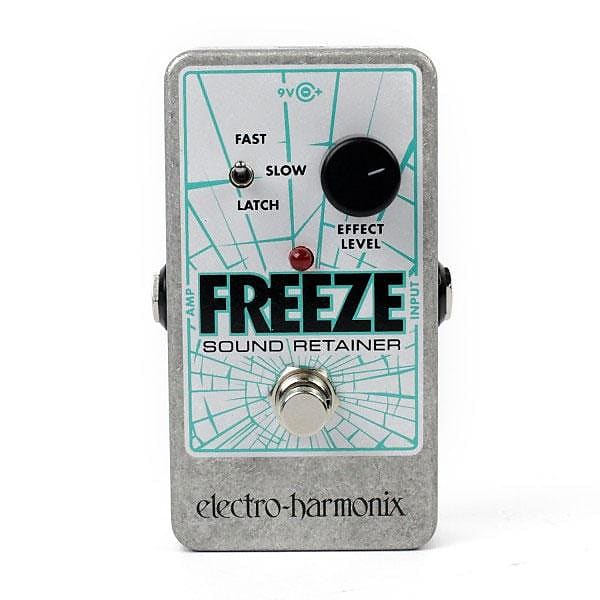Hi/Lo Pass is a new series that compares one more-expensive item (the hi-pass option) with one less-expensive option (the lo-pass). Either one may be right for you—so join us as we discuss what's good, bad, or the same about both.
I remember what a revelation it was when I first got an EHX Freeze. It was the day after the US federal election in 2012, and I bought it from a now-defunct guitar store in Chicago (Avenue N, if you're curious).
The idea of a piano-style sustain pedal had stuck with me since early childhood. I never understood the tech—and I never was very much of a piano player—but why couldn't I click a pedal, hold a chord, and continue to play guitar the same way I could do with a piano? It couldn't be that hard, could it?
The Freeze was the first fulfillment of that promise—whatever magic Mike Matthews and the EHX team had to conjure, they were the first. But fast-forward to 2018 and the Gamechanger Audio Plus took it a step (or two, or three, or five) further. So if you too want piano-like sustain on your guitar, which one should you buy? Well, it depends.
Lo-Pass: EHX Freeze
Electro-Harmonix had released the Freeze in 2010, but I had only recently become aware of it when I bought it in 2012. Immediately, it became a centerpiece of my guitar rig. In fact, it became my one-and-only plugged-in pedal for years.
I had hoped that the sustain would sound natural, that, when I clicked on the Freeze, it would sound like my most recent chord or note was just ringing out. But this… isn't exactly how it works. The split-second, instantaneous sampling of the Freeze results in a slightly different version of the original sound. While it's not synthetic, it sounds kind of synthetic, which isn't a bad thing, but it didn't quite live up to my preconceived expectations.
That said, the Freeze became enmeshed with my guitar-playing technique. With a signal chain that often included nothing else but amp overdrive, tremolo, and reverb, the Freeze became a second voice to my guitar.
I did use it to capture chords—with the toggle switch set to Slow, Effect Level knob set to noon—while playing melodies and harmonies over top. In a full band setting, it sounded like an organist was quietly doubling the chords of the song.
But where I used it most often was during solos and other instrumental passages, sometimes for its intended purpose of sustaining a note—and sometimes because of the strange noises it can evoke.
With its instantaneous capture of sounds, the Freeze can catch a sustained note and sustain it forever (this is, of course, its basic function)—and especially within a solo, with plenty of reverb, tremolo, and dirt, this can sound cool on its own.
But it can just as well capture the moments in between notes, like pick attacks, slides, and other odd moments. And when it does capture these in-between sounds, the Freeze acts as a kind of random noise machine, creating a musical cacophony around the notes you're playing. If and when it proves to be too much, you just let go of the footswitch, and you're back to your pure guitar signal.
Hi-Pass: Gamechanger Audio Plus
There may have been some worry from the Gamechanger Audio folks when they released the Plus. It was their first pedal, it took more than a year of long nights and weekends to develop (they all had day jobs still), and at the end of that effort, critics might dismiss it as just a more expensive Freeze. There is, however, a difference.
The Gamechanger Plus can do everything the Freeze can do and more. They are both real-time samplers—the Plus captures an instantaneous moment of your playing in the same way the Freeze does. And as such, it still doesn't quite sound 100% realistic to the chord or note you struck, a slight timbral difference that sounds not-quite-like a guitar. However, with the Sustain, Rise, and Tail knobs, you can fine-tune how the sustain effect swells and drops, which can lead to a more natural-sounding effect.
The Plus also offers more expanded features, like the Group mode toggle switch, which lets you to capture not just one or two but up to five moments back-to-back-to-back. The Freeze, on the other hand, only lets you hold one chord or note at a time. While still limited compared to a piano, the five-layer Plus lets you build chords piece by piece and create wide, lush soundscapes. In addition, it has a built-in effects loop that lets you carefully add other pedals into your signal chain. Lastly, you can buy the Plus with an additional Wet footswitch that lets you quickly shut the Wet mix on and off—and you can split your dry signal out separately.
Perhaps best of all, the actual pedal mechanism of the Plus is quiet and smooth to operate, while the Freeze's standard switch will click and clack with a fury as you futz around with it. While many players opt to mod the Freeze for a quieter operation, which is easy enough to do, it nonetheless comes stock with a noisy footswitch.
Verdict: Because the Plus is a more-capable machine, one that greatly adds to the feature set of the Freeze, you really do owe it to yourself to buy the Plus if it's within your budget. However, take it from someone that happily played a Freeze for eight years (before upgrading to a Plus): If all you want is momentary, instantaneous sustain, you won't be disappointed with the cheaper option.


